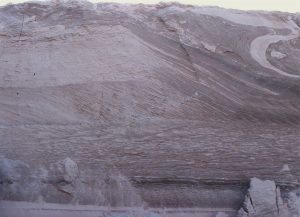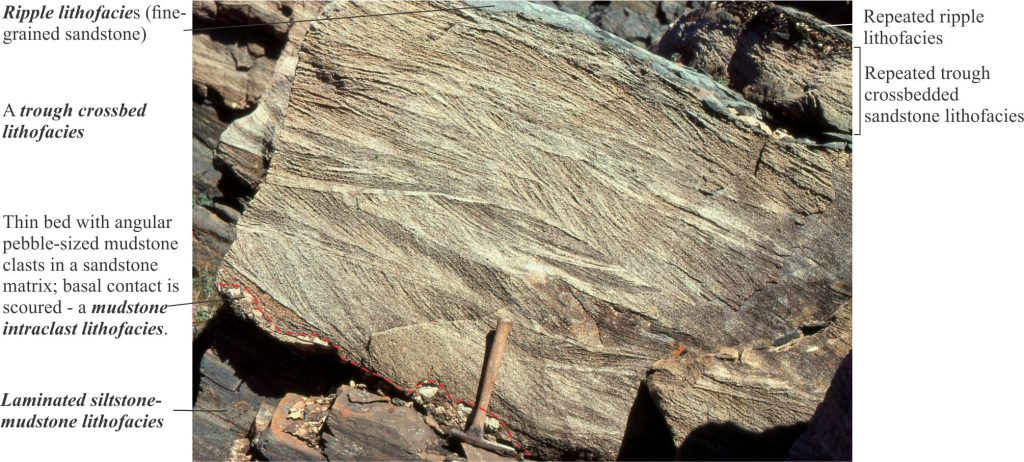
Lithofacies are the foundation of sedimentary rock description and interpretation
This series of articles deals with the description and interpretation of sedimentary rocks. The focal point in each article is the lithofacies, the basic descriptive unit for all sedimentary rocks; it is the starting point for any investigation.
Lithofacies are the cornerstone for a hierarchy of analytical tools:
- Lithofacies (sensu stricto).
- A hierarchy of surfaces that bound or separate individual lithofacies and lithofacies assemblages.
- Architectural elements, (sensu A.D. Miall, 2006, 1985) that define repeating or commonly occurring patterns of facies associations and bounding surfaces.
- 1D, 2D, and 3D profiles that show the relationships among lithofacies assemblages, architectural elements, and stratigraphic trends.
- Facies models that encapsulate all the above information.
The grand intent in this series is to examine all these analytical tools. However, we must first deal with specific sedimentary lithofacies.
The complete list of lithofacies with active links can be found here
Sedimentary lithofacies defined
Sedimentary lithofacies (or facies) were originally defined by Anton Greesly in 1836, as an objective description of sedimentary beds using all observable characteristics. Criteria commonly used to identify lithofacies include:
- Rock body geometry and bounding surfaces,
- Dimensions,
- Colour,
- Composition (siliciclastic, carbonate, evaporitic, volcaniclastic, carbonaceous, chemical),
- Grain size (gravel, sand, mud),
- Internal organisation (e.g., crossbedding, grain-size grading),
- Body and trace fossils,
Greesly recognized that the complex and sometimes bewildering array of bedding styles, sedimentary structures, and fossils that one could see in outcrop, could be simplified into a manageable number of lithofacies, many of which are repeated throughout stratigraphic successions or change to different lithofacies along the lateral extent of a bed.
This is a rational approach to sedimentary rock description that has stood the test of time. The key elements of lithofacies descriptions are that they derive from reasonably objective criteria, and they simplify the complex geology. An example of this approach is shown below.

In the example, four lithofacies suffice to describe the outcrop: laminated mudstone-siltstone, mudstone rip-up, trough crossbedded grainstone, and fine-grained sandstone with asymmetric ripples. A description of the trough crossbed lithofacies (for example) would include the following observations: Pale brown to grey, medium- to coarse-grained sandstone composed of carbonate and siliciclastic sand, abundant trough crossbeds (spoon-shaped basal contacts and concave foresets), an undulating, scoured basal contact that contains pockets of mudstone intraclasts (outlined in red), and a gradational contact with the overlying ripple sandstone lithofacies. The fourth is a laminated mudstone-siltstone lithofacies below the hammer.
The four lithofacies are repeated elsewhere in the stratigraphic section which means we can apply the same lithofacies designations. However, we need to be aware of possible variations as we move laterally or vertically through a stratigraphic section. For example, the trough crossbed lithofacies may incorporate some pebbly sandstone. In this case, do we modify the lithofacies definition to include the coarser grain size, or do we define a new lithofacies – begging the question of scale.
Lithofacies scale – use common sense
The scale of a lithofacies is basically the prerogative of the observer, a good rule but one that hopefully encourages common sense. Ideally, a lithofacies should encapsulate as much sedimentological information as possible because this will determine the efficacy of your interpretation. The pebbly trough crossbedded sandstone noted above is a good example of the decision-making processes:
- Is the transition from sandstone to pebbly sandstone gradual or abrupt?
- Is the transition repeated stratigraphically?
- Are there other significant lithological changes, such as scale of crossbeds?
- Does the proportion of gravel change stratigraphically or laterally?
- If you modify the existing lithofacies definition, will you potentially lose information?
- If you define a new lithofacies will this create a less manageable number of lithofacies (because you should apply the same logic to other lithofacies variations)?
In the end, how we define a lithofacies should depend on utility and reproducibility.
Lumping and splitting – more common sense
A single bed may consist of multiple lithofacies. For example, a sandstone bed may exhibit both planar and trough crossbeds – if we labelled this a crossbedded sandstone lithofacies, then we might overlook some important information (because the two kinds of crossbeds form under different hydraulic conditions). In this case, the sandstone would be better described as containing a planar crossbed lithofacies and a trough crossbed lithofacies.
Likewise, a turbidite will present in outcrop or core as a single bed or flow unit, but contain several distinct sedimentation units or lithofacies, each formed under different conditions of sediment grade (grain size, sorting) and fluid dynamics. The iconic Bouma Sequence with its 5-fold lithological subdivision, and the more recent models presented by D. Stow (fine-grained turbidites) and D. Lowe (coarse-grained turbidites) come to mind. We could refer to the entire bed as a turbidite facies, but in pursuing this we might omit turbidites in which certain parts of the depositional sequence are missing. And knowing which turbidites show complete and incomplete Bouma-Stow-Lowe flow units is critical to any interpretation of submarine fan evolution.
Interpreting lithofacies
Individual lithofacies, such as planar crossbedded sandstones, may be common to several different depositional environments such as marine shoreface or platform (carbonate and siliciclastic), tidal channels and tidal deltas, terrestrial alluvial fans, aeolian dunes, and the complete spectrum of channel types in deltas and low to high sinuosity, axial or dispersive fluvial systems. Rarely does a single lithofacies point to a specific depositional setting (there are a few exceptions).
We make use of lithofacies by overlaying interpreted qualities and quantities – primarily the processes involved in their formation. We can do this by observing the formation of analogous processes, such as stratification or bedforms, in experiments and natural recent environments where the conditions for deposition are measured (e.g., critical flow velocities and water depths, grain size). For the planar crossbedded sandstone example we could observe the migration of dune-like bedforms in an experimental flume, and demonstrate their formation taking place under lower flow-regime, subcritical conditions. We can also observe the bedform geometry in three dimensions and excavate 2D profiles that reveal the structure of the accreting crossbed foresets, then compare these characteristics with the ancient bedforms and crossbeds found in outcrop. By doing this, we derive some understanding of the hydraulic conditions for planar crossbeds that we encounter anywhere in the rock record. Note however, this information alone still does not help us isolate a specific environment of deposition. To do this we need to know something about other, associated lithofacies, their bounding surfaces, 3D geometry, and whether they are part of a stratigraphic trend.
Identification of lithofacies is an important first step towards deciphering the environment of deposition of a sedimentary succession, and the broader implications of these paleoenvironments in terms of processes that govern sediment derivation, dispersal, and deposition at the scale of an entire sedimentary basin.
The complete list of lithofacies with active links can be found here
Posts on Geological models
Geological models: An introduction

















